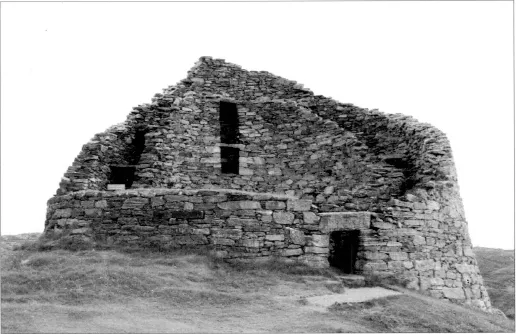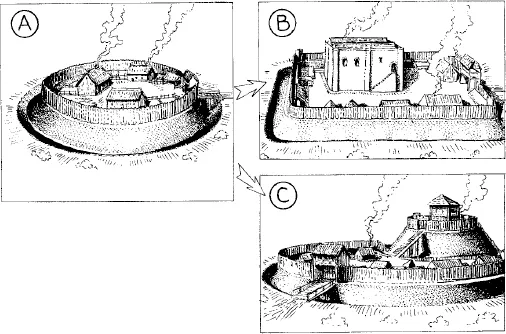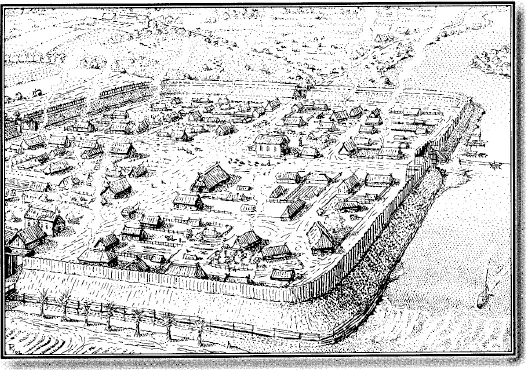![]()
SECTION
I
THE HISTORY
OF
ENGLISH CASTLES
![]()
CHAPTER 1
The Origins of Castles
FIG 1.1: PEVERIL CASTLE AND MAM TOR, DERBYSHIRE: The lines along the ridge of the hill in the background with the concave landslip are from an Iron Age hillfort, built to protect a settlement within. The castle walls in the foreground, however, were built by the local lord some 1,500 years later as part of a defended home and military base from which his estate below could be patrolled. Although some hillforts are known today as castles, we will be focusing on the true medieval structures which uniquely filled this dual role of home and garrison.
What is a Castle?
Before looking for its origins it is important to define what exactly we mean by a castle - and just as crucially what it is not. An arrangement of towers, battlements, earthworks and gateways does not automatically constitute a castle, for these elements have all been used before and since in other types of fortifications and buildings.
FIG 1.2: DUN CARLOWAY BROCH, ISLE OF LEWIS: The remains of a circular broch exposing its hollow walls between which stairs were built and a central area accessible through the low doorway to the front.
Iron Age man dug ditches, raised banks mounted with wooden fences and formed complicated defensive gateways around the tops of prominent hills up to 1,700 years before castle moats and palisades were erected by invading Normans. They were a place of defence for a community and any attackers were usually repelled by men standing outside the perimeter fence.
The remains of about five hundred circular stone towers are dotted through the north and west of Scotland, many of them pre-dating the castle by at least a thousand years. These brochs were strongholds with a guarded narrow entrance, stairs rising through hollow walls, and timber platforms within the central area, similar to the medieval castle tower. The Romans constructed forts in towns, along Hadrian’s Wall and around the south and east coast of England. These featured stone walls with battlements and powerful gateways protected by round towers, again much in common with our idea of a castle. Since the medieval period many lords have built new, so-called castles which, despite having imposing façades and often being sited upon an earlier fortification, are exposed as shams by their large window openings filled with glass, arrangements of towers designed to please the eye, and surrounding gardens rather than defensive earthworks.
Despite appearances the above examples are not castles, although to add to the confusion many are referred to as such, like Maiden Castle which is an Iron Age hill fort! The type that we will be focusing on is the true medieval castle. They differ from these other structures in that they fulfilled a dual role as both the home of a king, baron or his tenant and as a fortification from which to attack or defend his estates. These imposing structures reflected the power and authority of those who built them and were local centres of government and justice. They were also an important element of the social structure known today as the feudal system. So it is in the origins of feudalism that we find the first castles.
Feudalism
Not since the Roman Empire had collapsed in the 5th century had one man ruled such a large part of mainland Europe. The year was AD 800 and the man was Charles, King of the Franks, better known to history as Charlemagne. His empire spread across modern day France, Germany, Austria and down into Italy. To manage such a large territory he broke the land down into counties with nobles to defend and govern them. In return for this land a noble would be expected to provide armed men at a time of war. Charlemagne, in common with most rulers through the Middle Ages, had no standing army.
Another habit inherited from their Germanic past was for the Franks to split the lands amongst their sons when they died. Although Charlemagne had only one surviving son, Louis, he in turn had three competitive heirs who divided the Empire three ways in AD 843, breaking down central government and heralding a century of civil unrest. Not only did these kings have to tackle the problem of lesser nobles gaining too much power over their territories but they also had to face up to new external threats from the Magyars, the Saracens and in particular the Vikings. With their fast moving ships which could proceed upriver, the Vikings could strike quickly far inland. The Franks, though, had developed a secret weapon, the stirrup. This gave the horse rider a firm footing so that, when he charged, his and the animal’s weight was behind the lance, which was more effective than just throwing it. Hence the armoured soldier on horseback, or knight, was born, allowing for the formation of local cavalry forces that could respond quickly to any invader.
The feudal system developed alongside these military changes in order to physically and financially support them. Although it varied in structure, it basically formed a pyramid shaped social order with the king at the top. Below him were the vassals, a class of professional fighting men who often developed into troublesome local aristocrats, knights who might hold an estate or manor of their own, and farmers and peasants who gave up former types of land holding to fall under the protection of this system. Each level would receive an amount of land from the one above, and in return would provide services and produce to their superior. This arrangement was crucial to the knight for it provided him with an income and the manpower that he needed for training, armour, equipment and horses. Being a medieval knight was an expensive occupation!
For the feudal system to work the kings, dukes, counts and their vassals required local bases, which would be a home from which to administer and oversee their territory yet at the same time a garrison to house and equip their forces. These would not be large army forts which could be defended by thousands of soldiers, but more numerous local defensive structures which would have to resist attack with a smaller number of men.
The First Castles
The first fortifications built by the competing local lords were probably no more than a ditch and bank, topped by a palisade erected around their halls and ancillary buildings. The earth dug from the outer ditch was conveniently pushed up inside to make the bank, making the slope which confronted any attacker even more formidable. At some point a watch tower could have been added to guard a crucial river crossing or important trading centre where castles were usually strategically placed. These may have developed earthen ramps around their bases to protect their lower parts from fire and to gain height. Another change which may have occurred was for the lord’s hall to be isolated in its own defensive area, separate from the ancillary buildings within their own fortification.
Although the Viking threat was used as a reason for building these early castles, the real motivation of the nobles was probably competition with their neighbours. To possess a stronger, more advanced castle enabled the noble to hold on to or invade neighbouring lands. By the middle of the 11th century two types of fortification had evolved. An enclosure castle which contained a large building called a donjon within a surrounding bank and palisade (fig 1.3B) and a motte and bailey castle which had a watch tower fully elevated upon a mound with a separate enclosed area below (fig 1.3C). Both of these types were built by the invading Normans in England after 1066 and therefore will be explained in detail in the next chapter.
FIG 1.3: Drawing (A) shows how an early type of castle on the Continent may have looked. By the 11th century the stone donjon in castle (B) and the motte and bailey in (C) had developed from this earlier type.
While the Old Frankish kingdom disintegrated into localised infighting, across the Channel in Saxon England the threat from Vikings had a different effect. In the late 9th century the Vikings, in this case from Denmark (known as Danes), began to settle in England. They were looking to settle rather than just pillage and would have almost overrun the country were it not for stout resistance from Alfred, the King of Wessex. As a result the country was split diagonally in two, and to reinforce the boundary of Alfred’s southern and western region he established fortified towns called burghs, with earth banks and ditches surrounding the settlements. These were the nearest the Saxons came to building a castle but, like the hillforts of the Iron Age, they were communal defences and were not personal structures for overseeing an estate.
FIG 1.4: A view over an imaginary Saxon burgh showing the bank with a ditch outside and the gravel-surfaced roads crossing in the middle. A road also runs around the inside of the bank to permit easy access to any part of the defences at time of trouble.
While Danes were colonising the east and north of England, another Viking group from Scandinavia had become such a force on the other side of the Channel that the then king of the Old West Frankish kingdom (soon to become France) had g...






